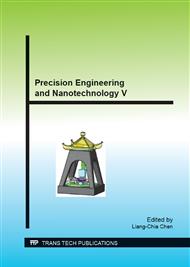p.398
p.402
p.411
p.417
p.423
p.430
p.437
p.446
p.453
Identification on Nonlinear Friction Model and Tracking Control for a Ball-Screw Actuated Stage Using Modified Charge System Search
Abstract:
High precise positioning and high-speed performance are demanded for servo mechanical systems in recent industry. However, the nonlinear friction is a main factor to make the positioning mechanism imprecision. To improve the positioning the positioning precision of stages driven by ball-screws, there are two types of compensations including model and non-model based methods. In this study, the LuGre friction Model is applied to model the nonlinear friction behavior for a ball-screw driven stage. A Modified Charge Search System (MCSS) was proposed to identify the system’s parameter. After the system’s parameters are obtained, a feed-forward control integrated with a disturbance observer is proposed to eliminate the external disturbance and improve its tracking performance.
Info:
Periodical:
Pages:
423-429
Citation:
Online since:
August 2014
Authors:
Price:
Сopyright:
© 2015 Trans Tech Publications Ltd. All Rights Reserved
Share:
Citation:


